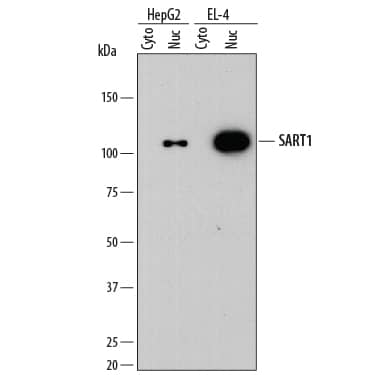Human SART1 Antibody
R&D Systems, part of Bio-Techne | Catalog # MAB8034

Key Product Details
Species Reactivity
Applications
Label
Antibody Source
Product Specifications
Immunogen
Asn647-Lys800
Accession # O43290
Specificity
Clonality
Host
Isotype
Scientific Data Images for Human SART1 Antibody
Detection of Human and Mouse SART1 by Western Blot.
Western blot shows lysates of HepG2 human hepatocellular carcinoma cell line and EL-4 mouse lymphoblast cell line. Gels were loaded with 20 µg of HepG2 and 30 µg of EL-4 cytoplasmic (Cyto) extracts and 10 µg of HepG2 and 15 µg of EL-4 nuclear (Nuc) extracts. PVDF membrane was probed with 1 µg/mL of Mouse Anti-Human SART1 Monoclonal Antibody (Catalog # MAB8034) followed by HRP-conjugated Anti-Mouse IgG Secondary Antibody (Catalog # HAF018). A specific band was detected for SART1 at approximately 120 kDa (as indicated). This experiment was conducted under reducing conditions and using Immunoblot Buffer Group 1.SART1 in HepG2 Human Cell Line.
SART1 was detected in immersion fixed HepG2 human hepatocellular carcinoma cell line using Mouse Anti-Human SART1 Monoclonal Antibody (Catalog # MAB8034) at 10 µg/mL for 3 hours at room temperature. Cells were stained using the NorthernLights™ 557-conjugated Anti-Mouse IgG Secondary Antibody (red, upper panel; Catalog # NL007) and counterstained with DAPI (blue, lower panel). Specific staining was localized to nuclei. View our protocol for Fluorescent ICC Staining of Cells on Coverslips.Applications for Human SART1 Antibody
Immunocytochemistry
Sample: Immersion fixed HepG2 human hepatocellular carcinoma cell line
Western Blot
Sample: HepG2 human hepatocellular carcinoma cell line and EL‑4 mouse lymphoblast cell line
Formulation, Preparation, and Storage
Purification
Reconstitution
Formulation
Shipping
Stability & Storage
- 12 months from date of receipt, -20 to -70 °C as supplied.
- 1 month, 2 to 8 °C under sterile conditions after reconstitution.
- 6 months, -20 to -70 °C under sterile conditions after reconstitution.
Background: SART1
Hypoxia-associated factor (HAF), also known as SART1, is a widely expressed 125 kDa intracellular protein that promotes assembly of the U2-type pre-mRNA spliceosome. SART1 is also an E3 ubiquitin ligase that promotes the ubiquitination and degradation of HIF-1 alpha. In contrast, it enhances the transcriptional activity of HIF-2 alpha. SART1 is upregulated in many tumor types and enables tumor growth during chronic hypoxia. Within amino acids 647-800, human SART1 shares 100% aa sequence identity with mouse and rat SART1.
Long Name
Alternate Names
Gene Symbol
UniProt
Additional SART1 Products
Product Documents for Human SART1 Antibody
Product Specific Notices for Human SART1 Antibody
For research use only

